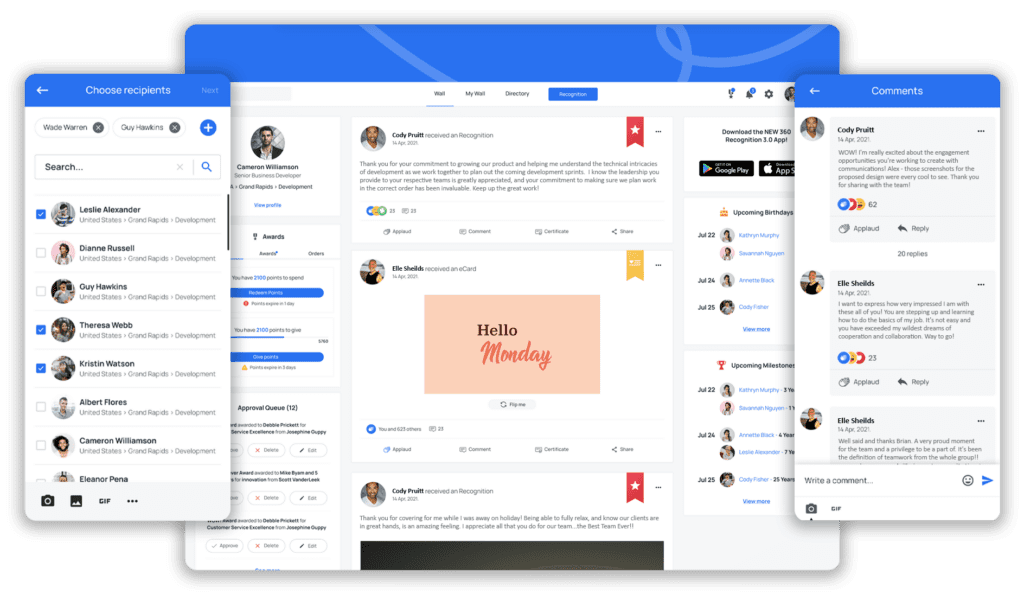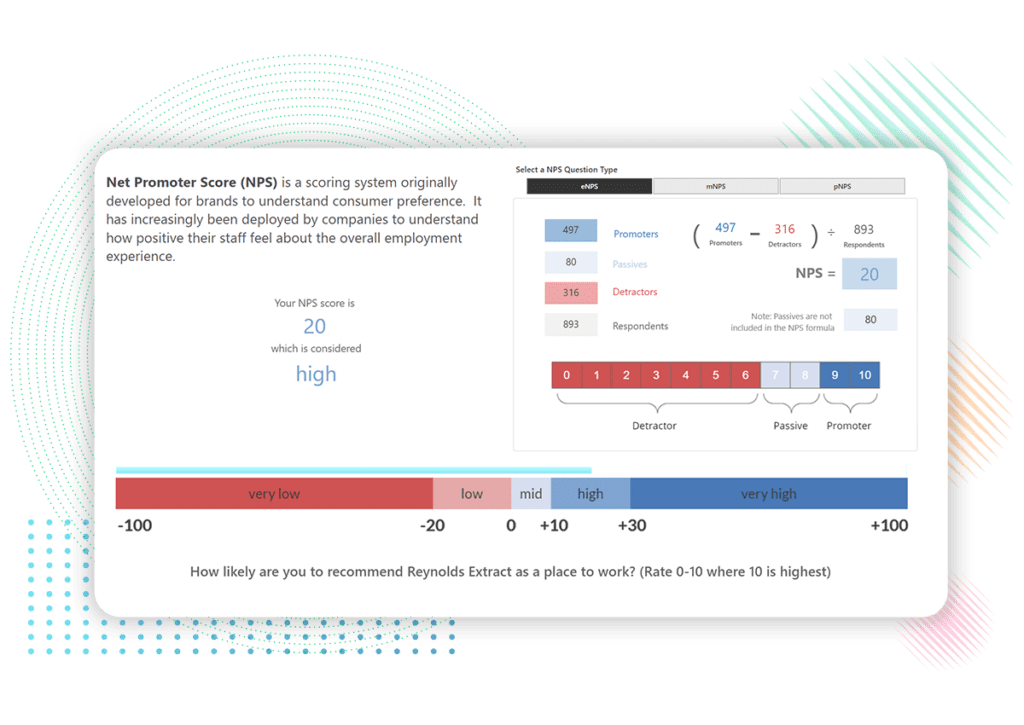August 10, 2023


Companies today are paying more attention to employee engagement possibly than ever before. This is because, in today's climate, employee engagement is a great predictor of overall company success.
From improved retention, productivity, and morale, to decreased absenteeism and workforce turnover, engaged employees are directly correlated with improved business outcomes.
Unfortunately, job engagement in 2022 declined to a mere 32% – down from 36% in 2020 and 34% in 2021. Furthermore, employee disengagement is on the rise, with 18% of employees now reporting being actively disengaged.
To help ensure this trend doesn't happen at your company, it's important to pay attention to the predictors of employee engagement.
Here, we'll explore what they are and what you can do to promote job engagement.
What is Employee Engagement?
Engagement is critical for any significant relationship, but according to organizational psychology, it's what makes the difference between average teams and thriving ones.
Employee engagement refers to the commitment, involvement, and enthusiasm employees have toward their workplace and work culture.
It’s about the personal connection employees feel with their job, colleagues, and the organization as a whole.
While employees may have job satisfaction, employee engagement goes a step deeper and asks how involved are they? How open are they to potential "better offers"? How do they feel when they begin work each morning?
By looking at common predictors of employee engagement, organizations can begin to spot trends, correct issues, and increase employee engagement overall.
Top 5 Predictors of Employee Engagement
While it's not possible to predict the engagement level of every employee, you can lay a solid foundation that sets you up for the best possible outcome.
1. Effective Leadership
We've all heard the saying that people don't quit jobs they quit managers. While true, bad bosses are unfortunately everywhere.
So much so, a survey conducted by Trinity Solutions found as many as 79% of people have experienced poor management.
And of the people who reported working for a micromanager, 85% said it had decreased their morale and 71% said micromanagement interfered with their job performance.
An ineffective leader also hinders overall job satisfaction and job engagement.
Instead, leaders should be sure to prioritize helping when needed, providing autonomy, trust, and clear and reasonable expectations.


2. Provide Career Growth Opportunities
WorkStep surveyed over 18,000 hourly workers across 150 companies and found that lack of career growth was the top reason for turnover. In truth, this finding should be unsurprising.
Expanding knowledge and skills is an important aspect of overall wellness. So, being able to do so at work helps contribute to job satisfaction and can help individuals become a more engaged employee.
In fact, companies with a culture of growth tend to attract and retain high-performing employees who develop stronger relationships with the company.
This is especially true for younger employees. According to a LinkedIn study, 40% of young workers said they were willing to accept a 5% pay cut to work in a position that offered career growth opportunities.
Additionally, 76% of Gen Zers want more opportunities to move up or increase responsibilities at work.
So, talk to your employees. Learn what they're goals are and find ways to cultivate the skills that will help them get there.


3. Emphasize Work-Life Balance
A key element for preventing burnout and promoting job engagement is a healthy balance between employees' work life and personal life.
So much so, a study by Indeed found that 36% of all workers say more time off could help reduce their burnout.
Unfortunately, offering more PTO oftentimes doesn't solve the burnout issue. In fact, a Glassdoor survey found that while paid time off proved to be more important for employees than pay raises, many people still don't utilize their time off.
This should inspire leaders to consider why their employees may feel like they can't utilize their time off. Are their deadlines too tight? Is there a lack of support in their absence? Is there a company culture of simply not taking time off?
Combat this issue by finding ways to support work-life balance. For example:
-
- Ensure your team knows how their PTO works, where to find it, and how to submit a request
- Lead by example - unplug after hours and use your own PTO
- Offer and encourage using mental health days
- Host non-work-related events for fun, like happy hours, team lunches, and events off campus
- Regularly check in with your team to ensure their workloads are manageable


4. Foster a Recognition Culture
In any organization, employee recognition should be a top priority. Recognition is simple, accessible, and effective when done right.
Employee recognition is also directly correlated with increased employee engagement, retention, morale, and more.
In fact, research shows that employee are nearly 3 times more likely to be highly engaged when they believe they'll be recognized for their work.
So, when considering predictors of employee engagement, recognition needs to be considered too.
Whether it's an informal effort to say "thank you" more often to employees, or a formal recognition program with peer recognition, milestone awards, incentives, and SWAG - find what works for your organization.
5. Get Employee Feedback
The most effective way to stay informed about your employees' engagement is to ask them.
Pulse surveys provide anonymous feedback about your company's culture, employee satisfaction, engagement, and more.
Whether you think your employees are engaged or not, it’s important to start on the right foot and measure engagement.
Giving employee surveys is a great way to gain a deeper understanding of your current environment.
Be sure to send surveys on at regular cadence to be able to track and measure employee engagement over time.
Most importantly, take action. Use the results of the feedback you receive to drive real change. When employees are given survey after survey without seeing any change, they'll likely start to develop survey fatigue and/or disengagement.
While there are many factors that go into employees feeling organizational commitment, these are a few key elements every organization should be considering.
Start Building an Engaged Team Today
Building an engaged team takes time and consistent effort for these to see significant changes within your organization.
If you’re looking for guidance along the way, Terryberry can help.
Terryberry provides solutions to help drive performance and retention through effective employee engagement. These solutions include:
- Pulse Survey Software: Be Heard is an employee engagement survey solution that's designed to enhance your employee experience while fueling business performance.
- Service Awards and Performance Awards: Recognize and reward employees based on years of service awards, anniversaries, or performance.
- Social Recognition: Empower your employees and managers to recognize their peers and celebrate successes with an easy-to-use social recognition application.
- Feedback and Communication: Unlock improved feedback and communications with employee and customer feedback solutions.
- Wellness Programs: We make it easy to run wellness programs and activity challenges that increase engagement, expand corporate health, and build team camaraderie.
Ready to learn more? Schedule a demo with our team to get a hands-on walkthrough of how Terryberry can transform the culture of your workplace.



